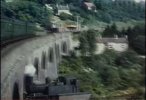An item which I recently came upon by chance -- pretty trivial, maybe; but to me, intriguing. It involves the Great Western's "Titfield Thunderbolt" line: Limpley Stoke -- Camerton -- Hallatrow, in Somerset. Although I had been aware that the route's longer segment, east of Camerton, had come on the scene late in the day; and that the entire line had lost its passenger service early: I had not realised until recent chance discovery, quite how late -- and as well as early, passenger-served for how very little time -- these respective things had been.
The route's full history, as recently discovered by me -- as follows. The section from Hallatrow on the Bristol -- Frome line, to Camerton -- some 4 to 5 miles -- was opened for all traffic in 1882 (I had known that it had come into being first). The 7 or 8 miles eastward from Camerton, to Limpley Stoke on the Bath -- Westbury route, following the defunct Somerset Coal Canal, were opened in 1908 (Camerton -- Dunkerton Pit, for freight only); and on eastward to Limpley Stoke, including opening for passenger throughout, in 1910. I had known that this part of the route had opened late in the railway age, but had failed hitherto to realise that it was this late. New to me also, was -- largely blameable, it appears, on World War I -- just for how very little time in all, a passenger service had run over the late-opened section (it would appear that from the outset, the passenger trains were disappointingly lightly used). Passenger service -- Limpley Stoke to Hallatrow throughout -- was discontinued with effect from 22 / 3 / 1915: one figures, a wartime economy measure, very early in the war. Freight continued throughout. Passenger was experimentally resumed in 1923 -- way after the return of peace -- but withdrawn again w.e.f. 21 / 9 / 1925. At that time, Camerton -- Hallatrow was closed for all traffic; freight (largely, coal mined at Dunkerton) thenceforth went in and out via Limpley Stoke. These freight workings carried on for another generation, ceasing in 1951. Filming for The Titfield Thunderbolt was carried out at the eastern end of the line -- Monkton Combe station being "Titfield" -- in 1952, while track was still down.
It can be reckoned that if the film-makers had not happened to choose this line for a film which became -- especially for railfans -- a classic; the line would have been one of the most obscure and overlooked -- and when notice taken of it, regarded as a failure and a farce (even if also hankered after by enthusiasts) -- of any branch lines belonging from way back, to Britain's big railway companies. With the ephemerally little time in which it was passenger-served east of Camerton (a bit over half a dozen years, including a long "intermission"); one would take it that it would have been a very few and lucky railway enthusiasts -- if any at all -- who experienced those regular passenger workings.
The route's full history, as recently discovered by me -- as follows. The section from Hallatrow on the Bristol -- Frome line, to Camerton -- some 4 to 5 miles -- was opened for all traffic in 1882 (I had known that it had come into being first). The 7 or 8 miles eastward from Camerton, to Limpley Stoke on the Bath -- Westbury route, following the defunct Somerset Coal Canal, were opened in 1908 (Camerton -- Dunkerton Pit, for freight only); and on eastward to Limpley Stoke, including opening for passenger throughout, in 1910. I had known that this part of the route had opened late in the railway age, but had failed hitherto to realise that it was this late. New to me also, was -- largely blameable, it appears, on World War I -- just for how very little time in all, a passenger service had run over the late-opened section (it would appear that from the outset, the passenger trains were disappointingly lightly used). Passenger service -- Limpley Stoke to Hallatrow throughout -- was discontinued with effect from 22 / 3 / 1915: one figures, a wartime economy measure, very early in the war. Freight continued throughout. Passenger was experimentally resumed in 1923 -- way after the return of peace -- but withdrawn again w.e.f. 21 / 9 / 1925. At that time, Camerton -- Hallatrow was closed for all traffic; freight (largely, coal mined at Dunkerton) thenceforth went in and out via Limpley Stoke. These freight workings carried on for another generation, ceasing in 1951. Filming for The Titfield Thunderbolt was carried out at the eastern end of the line -- Monkton Combe station being "Titfield" -- in 1952, while track was still down.
It can be reckoned that if the film-makers had not happened to choose this line for a film which became -- especially for railfans -- a classic; the line would have been one of the most obscure and overlooked -- and when notice taken of it, regarded as a failure and a farce (even if also hankered after by enthusiasts) -- of any branch lines belonging from way back, to Britain's big railway companies. With the ephemerally little time in which it was passenger-served east of Camerton (a bit over half a dozen years, including a long "intermission"); one would take it that it would have been a very few and lucky railway enthusiasts -- if any at all -- who experienced those regular passenger workings.


